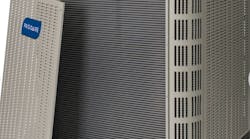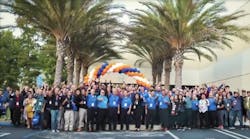The HVACR industry has known that hydrochlorofluorocarbons (HCFCs) were going to be phased out of the U.S. market since the signing of the Montreal Protocol in 1987. Passage of the Title VI Clean Air Act Amendments in 1990 established the specific phaseout schedule of HCFC-22, but the regulatory details of the substance's phaseout were certain only through 2009.
The U.S. Environmental Protection Agency (EPA) released in late 2008 two proposed rules for establishing the regulatory framework for the next stages in the phaseout of HCFCs. Specifically focused on R-22 and R-142b, the proposed rules created significant confusion and concern within our industry. HARDI's HCFC Rulemaking Task Force, formed in June 2008, has worked feverishly with the EPA and our industry partners to protect the interests of HVACR distributors and the industry's greater good. It is important for the industry to understand what we have accomplished up to this point and where we see the direction of refrigerant use in the United States. Below is a timeline of these rulemakings. We have also provided a sidebar with recommendations that every HVACR distributor should consider immediately.
March 2008 — HARDI begins discussions with EPA on timeline, scope and intent of the next HCFC phaseout regulations.
May 2008 — HARDI Refrigeration Council hosts presentation by EPA staff on initial framework of HCFC phaseout regulations. EPA indicates uncertainty regarding the definition of “manufactured prior to Jan. 1, 2010,” as it pertains to split air-conditioning and refrigeration systems — whether it is when a product comes off the assembly line or when all of the components of a complex system are connected. EPA also reports that a proposed rule is in the works to address OEM concerns about a regulatory loophole that would allow the continued importation of precharged HVACR equipment after Jan. 1, 2010, despite a ban on the domestic manufacture of such products that would take effect at that time.
June 12, 2008 — The EPA releases a revised estimate of the servicing needs for HCFC-22, which undergoes immediate review.
June 16, 2008 — The EPA holds a public meeting to outline and highlight the proposed rules that would be released later in the year. In response to the revised servicing estimate, HARDI establishes the HCFC Rulemaking Task Force comprised of distributor member volunteers to assist staff with the preparation of written comments and coordination with the EPA and industry partners throughout the rule-making process.
July 2008 — The newly formed HARDI HCFC Task Force develops and sends a letter to the EPA outlining several discrepancies and inconsistencies found in the revised servicing estimate for R-22 systems. This letter also urges the EPA to use the pending proposed rules as an opportunity to eliminate market confusion by simply following the equipment production ban process used during efficiency standards transitions, rather than trying to implement unenforceable refrigerant use bans that attempted to draw a distinction between virgin and reclaimed refrigerants.
Sept. 2008 — EPA approaches HARDI about assisting with the development of a refrigerant recovery location tool.
Oct. 2008 — EPA asks to attend HARDI Fall Conference's Refrigeration Council meeting to discuss ideas for new drivers of refrigerant recovery and reclamation. During a presentation on the California Air Resources Board's proposed regulations on management of high global warming potential refrigerants, EPA's Jeff Cohen includes outline of proposed rulemaking on ban on sale and distribution of products precharged with virgin R-22.
Dec. 22, 2008 — The EPA releases “pre” copies of two proposed rule- makings. The first would ban the sale or distribution of appliances and components precharged with virgin R-22 or R-142b after Jan. 1, 2010. This also includes imported products and products destined for export. The second proposed rule would establish the allocation allowances for HCFCs from 2010 to 2014. The two rules immediately cause major confusion and serious concerns for HARDI because the preamble language doesn't match the proposed amendments to the federal regulations. The preamble of the precharged rule indicates that precharged products in inventory at the end of 2009 cannot be sold or distributed after Jan. 1, 2010. The allocation rule defined “manufactured” with the completion of the refrigerant loop which, for split systems, meant the point of installation.
Dec. 23, 2008 — HARDI's HCFC Rulemaking Task Force hosts conference call with EPA staff to discuss the two proposed rules. To the Task Force's surprise, the EPA states their interpretation of “manufactured prior to” leads them to believe that no refrigerant loops can be closed after Jan. 1, 2010, and charged with virgin R-22, and that would include loops of existing systems opened during servicing. This interpretation essentially bans the air-conditioning and refrigeration servicing after Jan. 1, 2010, and makes obsolete any R-22 equipment or component in inventory at the end of 2009.
Dec. 23, 2008 — AHRI submits a formal request to the EPA for a hearing on each of the two proposed rules. The EPA schedules hearings for Jan. 7, 2009, in Washington, DC. HARDI submits a request to provide an oral statement at both hearings, and the Task Force begins preparations for the hearing.
Jan. 2, 2009 — HARDI releases a summary of proposed rules based on the Dec. 23, 2008, meeting with the EPA. HARDI asks the EPA to review and approve the summary for accuracy, which they do, and then officially distributes it to the membership and industry partners.
Jan. 5, 2009 — HARDI and ACCA representatives meet with staff from the House Small Business Committee, and separately with the U.S. Small Business Administration's Office of Advocacy to raise awareness about the impact the proposed rules, if finalized with the recently stated intents, would have on small HVACR businesses.
Jan. 6, 2009 — HARDI hosts a meeting in Washington, DC, between the HCFC Rulemaking Task Force and AHRI's Government Affairs Committee and Unitary Products Council to discuss the proposed rules and prepare for the next day's hearings. HARDI conveys distributors' reluctance to invest in R-22 equipment if the possibility exists that they would have to write off anything unsold as of 12/31/09. HARDI and AHRI reach agreement on a definition of “manufactured” they both will recommend to the EPA in their respective statements the next day.
Jan. 7, 2009 — HARDI delivers oral statements at the hearing for the proposed ban on precharged appliances and the hearing for the proposed allocations of HCFC allowances. Two HARDI distributors also present individual statements outlining the cost in terms of jobs and dollars of stranded R-22 equipment and component inventories. HARDI recommends that the EPA adopt AHRI's definition of when a product is “manufactured” as when it enters manufacturers' initial inventory or clears U.S. customs. AHRI also recommends that the EPA lift the exemption for the continued installation of new appliances if charged with reclaimed refrigerant.
Jan. 14, 2009 — The EPA releases clarifications on the two proposed rules in the form of a three-page fact sheet in response to the many questions and concerns raised at the hearings. This fact sheet specifically addresses many of HARDI's concerns and specifies that the EPA does not intend to prohibit the servicing of existing R-22 systems. To this end, the EPA states its intent to classify condensing units as components. If these units have a manufacturing date before Jan. 1, 2010, wholesalers can then sell and distribute these items indefinitely for servicing purposes.
However, this fact sheet also outlines the EPA's plan to prohibit the “initial charging of new appliances” after Jan. 1, 2010, with virgin R-22, essentially establishing a ban on new installations of R-22 air-conditioning or refrigeration systems after 2009.
Jan. 16, 2009 — The SBA contacts HARDI to flesh out the small business concerns with the precharged rule as it pertains to wholesale distributors.
Jan. 21, 2009 — HARDI meets with EPA staff to discuss the fact sheet clarifications. The EPA reinforces the fact sheet's support for the continued servicing of existing appliances (systems) as well as their intent to prohibit new installations of A/C and refrigeration systems, which would include the expansion of existing systems. HARDI also receives confirmation of the EPA's intent to cover imported products under the ban of precharged appliances and components based on the equipment's stamped date of manufacture rather than the date the product clears U.S. customs. HARDI also restates its concerns regarding the proposed new installation ban as it pertains to delayed construction projects. The EPA acknowledged the issue and encouraged HARDI to offer potential solutions when submitting written comments.
Feb. 6, 2009 — HARDI submits formal comments to the EPA on the proposed ban on the sale or distribution of precharged appliances and components. In those comments, HARDI provides specific recommendations on how the clarifications in the fact sheet could be amended into federal regulations to provide certainty regarding the continued sale of precharged products in inventory before Jan. 1, 2010. Additionally, HARDI suggested exemption language for new construction projects that face delays beyond 2009 or cancellation after making investments in R-22 equipment.
This is as far as things had gone by the time this article was due. At the risk of ending up with egg squarely on our faces, the HCFC Rulemaking Task Force submitted HARDI's comments on the precharged rule, encouraged that the EPA had listened to and was supportive of HARDI's urging that the continued servicing of existing systems be explicitly permitted after Jan. 1, 2010. Further, we would be shocked if a final rule jeopardized the sale or distribution of precharged components in inventory before Jan. 1, 2010. The fate of new installation projects in 2010 that started in 2009 remains in question. HARDI and the SBA recommended that projects which obtained building code approval in 2009 receive an exemption from the ban applied to new installations.
HARDI went a step further by seeking additional considerations applied to equipment procured for new installation projects, which now face cancellation.
March 9, 2009, is the comment deadline for the allocation rule. HARDI has been in discussion with a wide range of stakeholders about the potential implications of the allocation process on HVACR distributors. HARDI's two greatest strengths throughout this and other government policy matters have been its willingness to solicit input and positions from all industry segments, and its unabashed devotion to the interests of HVACR wholesale distributors and the industry's greater good. These strengths will undoubtedly continue as the comment deadline approaches on the allocation rule. HARDI has concerns about how we determine the manufacturing date of an appliance, and the setting and allocation of R-22 supplies. We have certainly made progress to date. However, I shudder to think of where we might have found ourselves had we not been so engaged in this process. Any certainty regarding the future of R-22 equipment and components remains in question until the release of the two final rules sometime this summer.
Jon Perry, Refrigeration Council chair and president of C.C. Dickson Co. Contact him at [email protected].
THINGS TO CONSIDER AS A DISTRIBUTOR OF R-22 EQUIPMENT OR SUPPLIES
With the final release of the rules not expected until late July, can you risk not thinking about the following?
- What is your current inventory position on R-22 equipment?
- Have you modified your purchasing habits of R-22 products to better transition to R-410A?
- Do you have a plan to ensure you move all of your R-22 equipment if you need to?
- What are the implications of the long-term manufacturer warranties on these systems?
Other items to consider:
- With the decreased production of R-22 and the stoppage of R-22 equipment production at the end of the year, have you done enough to educate your customers and employees? Are they informing end-users of the changes?
- Are your contractor customers well prepared to sell HFC-using equipment?
- Do you have an R-22 reclaim program in place?
- Have you considered or tried any retrofit products for R-22?





